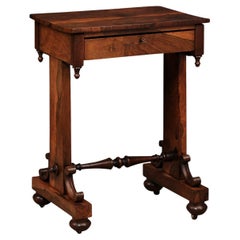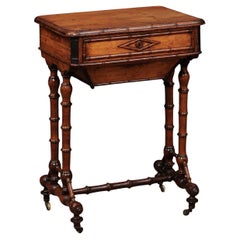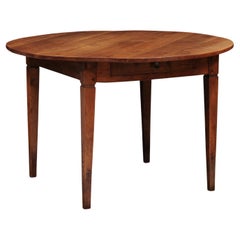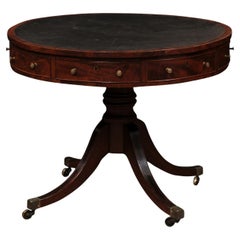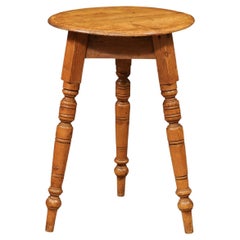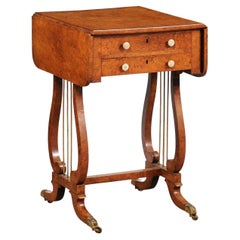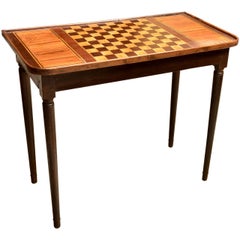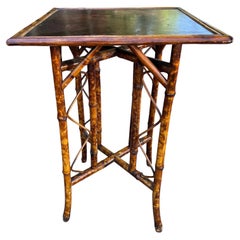William Word Fine Antiques Tables
to
Height
to
Width
to
Depth
to
10
10
1
1
3
7
10
2
2
2
2
9
4
4
3
1
10
10
10
19th Century English Rosewood Work Table with Drawer, ca. 1840
Located in Atlanta, GA
19th Century English Rosewood Work Table with Drawer, ca. 1840
Category
Antique 19th Century English Tables
Materials
Rosewood
19th Century English Faux Bamboo Work Table
Located in Atlanta, GA
19th Century English Faux Bamboo Work Table
Category
Antique 19th Century English Tables
Materials
Wood
19th Century French Fruitwood Round Breakfast Table with Square Tapering Legs
Located in Atlanta, GA
19th Century French Fruitwood Round Breakfast Table with Square Tapering Legs
Category
Antique 19th Century French Tables
Materials
Fruitwood
19th Century English Mahogany Drum Table with Black Leather Top
Located in Atlanta, GA
19th Century English Mahogany Drum Table with Black Leather Top
Category
Antique 19th Century English Tables
Materials
Leather, Mahogany
Late 19th Century English Pine Cricket Table with Turned Legs
Located in Atlanta, GA
Late 19th Century English Pine Cricket Table with Turned Legs
Category
Antique 19th Century English Tables
Materials
Pine
Early 19th Century Baltic Sewing Table in Birch with Drop Leaves, 2 Drawers
Located in Atlanta, GA
Early 19th Century Baltic Sewing Table in Birch with Drop Leaves, 2 Drawers
Category
Antique Early 19th Century Baltic Tables
Materials
Birch
17th Century Spanish Walnut Table with Lyre Shaped Carved Legs
Located in Atlanta, GA
17th Century Spanish Walnut Table with Lyre Shaped Carved Legs & Iron Stretchers
Category
Antique 17th Century Spanish Tables
Materials
Walnut
19th Century Painted Kitchen Table with 1 Deep Drawer & Tapered Legs, Sout
Located in Atlanta, GA
19th century painted kitchen table with 1 deep drawer & tapered legs, Southern Italy.
Category
Antique 19th Century Italian Industrial and Work Tables
Materials
Wood, Paint
18th Century French Louis XVI Period Kidney Shaped Tulipwood Table with Marble
Located in Atlanta, GA
18th century French Louis XVI period kidney shaped tulipwood table with drawer, cabinet door, & marble top.
Category
Antique Late 18th Century French Louis XVI Side Tables
Materials
Marble
French Louis XV Walnut Console with Marble Top
Located in Atlanta, GA
A Louis XV walnut console table with marble top. carved shaped apron with drawer and cabriole feet.
Category
Antique Mid-18th Century French Louis XV Console Tables
Materials
Marble
Related Items
19th Century English Game Table
Located in Southampton, NY
19th century late Regency English game table.
Category
Antique 19th Century British Regency Game Tables
Materials
Mahogany
19th Century English Bamboo Side Table With Chinoiserie Design
Located in Nashville, TN
This beautiful bamboo side table heralds from the English Aesthetic movement and features a unique chinoiserie themed hand painted top with black and deep oranges.
This could make a ...
Category
Antique 1880s English Tables
Materials
Bamboo
19th Century English Pine Cricket Table
Located in Woodbury, CT
19th century English pine cricket table with painted white legs.
Category
Antique 19th Century English Victorian Tables
Materials
Pine
Late 19th Century French Mahogany Side Table with Marble Top Plate
Located in Sofia, BG
French side table in white marble plate square top and gallery, the four tapered and fluted uprights joined by a crotch shelf and finished with div...
Category
Antique Late 19th Century French Louis XVI Side Tables
Materials
Mahogany
$2,022 Sale Price
25% Off
H 29.93 in W 11.82 in D 16.15 in
19th C. French Charles X Restoration Period Sewing Stand Work Table
Located in Forney, TX
A scarce period Charles X (1818-1834) French Restoration mahogany travailleuse sewing (thread stand - side table - jewelry dressing table) with light, warm, beautifully aged patina.
Born in France in the early 19th century, almost certainly Parisian work, exquisitely hand-crafted, this exceptionally executed example features ornate gilt bronze ormolu mounts, escutcheons, and elaborate gilt metal trim. Having a highly figured light mahogany hinged lid top, lifting open to reveal a striking finished interior with divided compartments and original inset mirror plate. The conforming rectangular case fitted with a faux drawer front over a dovetailed drawer with sectioned interior. Elegantly rising on oval-shaped medial shelf stretcher-joined curvacious legs.
Dimensions (approx):
27" High, 20" Wide, 13.5" Deep
Stunning light almost blonde antique mahogany coloring and mellow warm tone, superb wood grain detail, and charming, beautifully aged patina over the whole. Great shape overall. Retaining original antique character marks, wear consistent with age and indicative of minimal use, nothing that detracts from the aesthetics or functionality, but only adds to the overall authenticity, refined elegant warmth, luxurious sophistication, and cozy unpretentious rustic elegance.
Delivered cleaned, hand waxed, polished French patina finish, ready for immediate use and generational enjoyment!
What is Charles X style:
The comte d’Artois – or Charles X - was the son of the dauphin Louis-Ferdinand de Franc and Marie-Josèphe de Saxe. He succeeded his two brothers Louis XVI and Louis XVIII and became the King of France in 1824. Thirty years after the French Revolution, he wanted to embody the return of monarchy and became the leader of the catholic party . As the previous kings, he was crowned in 1825 but he was soon overthrown by the revolution in July, 1830, called "Trois Glorieuses". He left then for England, Scotland, Prague and Istria where he died in 1836.
Charles X style lasted from 1818 to 1834 and happened during the Bourbon Restoration (French Restoration). This style did not replace totally the style of furniture from the French Empire but it was different from the formalism in the Napoleonic era, during which strictness and simplicity were inspired by Greco-Roman art. Indeed, artistic fields flourished. In terms of furniture, this renewal was suggested by the softening of shapes. Even though the simple aspect from the French Empire was still visible, shapes became curvier with volutes and arabesques. Another distinction is the loss of the massive aspect of furniture and the decrease of dimensions in order to decorate smaller appartments. Handling ability and comfort were key-words in the making of furniture. Apartments had essential elements such as chests of drawers, big rounded tables in the dining room, desks or secretaries, armoires and even dressing tables, comfortable fainting couches in the living room, small tables, pedestal tables, as well as gondola chairs. The wavy aspect of the latters certainly represent Charles X style the best.
One of the most emblematic features of this style is the use of bois clairs – light woods in warm blond tones - and indigenous woods that are varnished in order to highlight the grains. Bird's-eye maple, ash trees, plane trees, yew trees, beech trees, olive trees and cedar trees were most likely to be used. Indeed, at the beginning of the 19th century dark woods were hard to find. In 1806, the Napoleon’s Continental System was established in order to ruin the United Kingdom by preventing the country from any business with the rest of Europe. Therefore craftsmen had to find alternatives from mahogany which was the most commonly used material at this time. After 1815, the import of wood was even more difficult because of peace treaties and the European political situation, which contributed to the popularity of the bois clairs and indigenous woods. The furniture was often decorated with fine inlays made out of dark wood representing foliage, which contrasted with the veneer. Even though these patterns can look like bronze decorations from the Empire era, they were far more simple and did not represent any military or mythological attributes. On the tables, trays were sometimes made out of marble as in the French Empire, but it was often put aside and inlaid veneer, Verre Eglomisé – a type of glass with a mirror finish –, mirror or porcelain from Sèvres or Paris were more likely to be used.
Decorative elements from the Monarchy were highly appreciated again as they suggested luxury. Indeed, marquetry work was particularly fashionable - Boulle marquetry thrived around 1820 as the works of the Levasseur family can show. In the same way, draperies and trimmings referred to the monarchist splendour. Fabrics were often white – the traditional colour of the Bourbons – or light coloured as oppposed to the typical green from the Napoleonic era.
One of the most symbolic figures from this period of time might be Jean-Jacques Werner (1791-1849), a cabinetmaker who worked for prestigious clients such as the Duchesse de Berry who was Charles’s step-daughter. His works can be seen at the Musée des Arts Décoratifs and at the Grand Trianon in the Palace of Versailles. The duchess’s appartments situated at the pavillon de Marsan and at the Palais de Saint Cloud illustrate Charles X style the best with furniture made out of bois clairs and ornamented with dark wood patterns or fine gold decorations.
Chales X style allows a transition between the sobriety of the Empire style and the abundant aspect of Louis-Philippe style. The gothic style started at this time through the "style à la cathédrale", inspired by religious architecture, which thrived from 1827 to 1830. Indeed, at the beginning of the 19th century, Romanticism put the spotlight on the Middle Ages. Cabinetmakers were not inspired by the medieval furniture but rather by architectural elements of churches and cathedrals. For instance the backs of chairs were decorated with arches shaped like rib and serration. In the same way, before Charles X abdicated, pieces of furniture were made out of dark woods – such as mahogany, which was used again in France – and were inlaid with light wood. Romanticism also influenced the layout of furniture in appartments to suggest movement through a mix of various styles, various shapes and various sizes, as opposed to the static aspect of Neoclassicism. The start of industrialisation and mechanisation also influenced this style as early technical developments led to the production of pieces of furniture in series.
Credit:
Marc Maison
Bibliography:
FANIEL Stéphane (Dir.), Le Dix-neuvième Siècle Français, Collection Connaissance des Arts, 1957, Hachette
SASSONE, Adriana Boidi, Furniture from Rococo to Art Deco, 2000, Evergreen
--
Extremely versatile:
As warm and attractive as it is useful, this remarkable antique table having the ideal size and small proportions for a variety of different uses, including as a side table, accent or occasional table, tall sofa...
Category
Antique Early 19th Century French Charles X End Tables
Materials
Bronze, Ormolu
19th Century English Lacquered Chinoiserie Table
Located in Bradenton, FL
19th Century English Chinoiserie lacquered table. Table has one drawer. Hand-painted Chinese landscape in rich colors of gold, mossy green,...
Category
Antique 19th Century English Chinoiserie Tables
Materials
Wood
English 19th Century Solid Pine Cricket Table
Located in Baton Rouge, LA
A fantastic English cricket table, made of solid pine, from the 19th century. These charming antiques make stylish side or occasional tables though they were made with a utilitarian ...
Category
Antique 19th Century English Other Side Tables
Materials
Pine
English 19th Century Solid Pine Cricket Table
Located in Baton Rouge, LA
An English solid pine cricket table used by scorekeepers for outdoor cricket games. The simple plank top rests over the table frame with three splayed le...
Category
Antique 19th Century English Other Side Tables
Materials
Pine
ebonized 19th Century Mahogany Round Center Empire Table with Marble Top
Located in Troy, MI
Found in France, this circa 1840s mahogany empire center table has a new, professionally applied ebonised finish. Gray and white streaked round marble top with a brass trimmed trefoi...
Category
Antique Mid-19th Century French Empire Center Tables
Materials
Marble, Brass
Early 19th Century Cherry Hand-Planed Gate-Legged, Drop Leaf Dining Table
Located in Louisville, KY
Not your ordinary drop-leaf table, this early 19th century cherry gate-leg, drop-leaf table was hand-planed and hand-turned to create a wonderful dining table that doubles as a conso...
Category
Antique Early 19th Century American Federal Tables
Materials
Cherry
$2,300
H 29 in W 48 in D 19.5 in
19th Century French Bleached Oak Table with Turned Legs and Bluestone Top
Located in Dallas, TX
A wonderful example of Louis XIII-style furniture, this oak table has a modified X-stretcher with six legs, all tightly turned. The wood has been bleached more recently, leaving the ...
Category
Antique 19th Century French Louis XIII Tables
Materials
Stone
$8,200
H 30.25 in W 94.5 in D 39.375 in
English Leather Top Drum Table C. 1930’s
Located in Los Angeles, CA
English leather top Drum table that stands on a four curved legs with carved acanthus leaf detail. The brown leather on the top is beautifully gold embossed around the edge of the to...
Category
Vintage 1930s English Other Tables
Materials
Leather, Mahogany
